Rolling Bridge Cranes for Sale, Custom Overhead Rolling Cranes
A Comprehensive Guide to Rolling Bridge Cranes: Enhancing Efficiency in Industrial Operations
Rolling bridge cranes, often referred to as overhead rolling cranes or movable overhead cranes, are essential pieces of equipment in industrial settings. These versatile machines are designed to efficiently lift, move, and position heavy loads within various work environments. Consisting of a bridge that spans the width of the workspace and moves along elevated runways, rolling bridge cranes are pivotal in streamlining material handling processes.
The significance of rolling bridge cranes cannot be overstated in modern industrial operations. These cranes significantly enhance productivity, facilitate streamlined workflows, and improve safety standards within warehouses, manufacturing facilities, construction sites, and more. Their ability to handle substantial loads with precision and speed makes them indispensable in various sectors, contributing to operational efficiency and cost-effectiveness.
The terms rolling shop crane, rolling bridge crane, overhead rolling crane, and movable overhead crane all refer to the same essential piece of equipment— the rolling bridge crane. They encompass a variety of overhead cranes featuring a bridge that traverses horizontally on elevated runways, offering mobility and adaptability in material handling tasks across industries.
Overview of Rolling Bridge Cranes
What is a Rolling Bridge Crane? A rolling bridge crane, commonly known as an overhead rolling crane or movable overhead crane, is a robust material handling device utilized in industrial settings. It operates by spanning the width of a workspace via elevated runways, utilizing a bridge that moves horizontally along the designated path. This bridge supports a hoist mechanism, enabling the lifting, movement, and precise positioning of heavy loads with ease and accuracy.
Components and Structure
- Bridge: The primary structural component of a rolling bridge crane, the bridge, is the horizontal beam that spans the width of the workspace. It travels along elevated runways using wheels or tracks attached to the crane runway beams.
- Hoist Mechanism: Mounted on the bridge, the hoist mechanism comprises a lifting hook or other load-bearing attachment. It utilizes ropes or chains wound around a drum to hoist and lower loads.
- End Trucks: These components are found at both ends of the bridge and house the wheels or tracks that allow movement along the runways.
- Runway Beams: Elevated tracks or beams serve as the path for the bridge to move horizontally within the workspace. They provide support and stability for the entire system.
- Controls: Rolling bridge cranes are operated using control panels or consoles. These controls manage the movement, lifting, and positioning of loads, ensuring precision and safety during operations.
Understanding these components and the overall structure is crucial for comprehending the functionality and operational capabilities of rolling bridge cranes. The design and configuration of these components may vary based on the specific type of rolling bridge crane, such as single girder, double girder, or box girder cranes, each tailored to suit different load capacities and operational requirements.
Types of Rolling Bridge Cranes
Rolling bridge cranes come in various configurations, each catering to distinct operational needs and load capacities. Some common types include: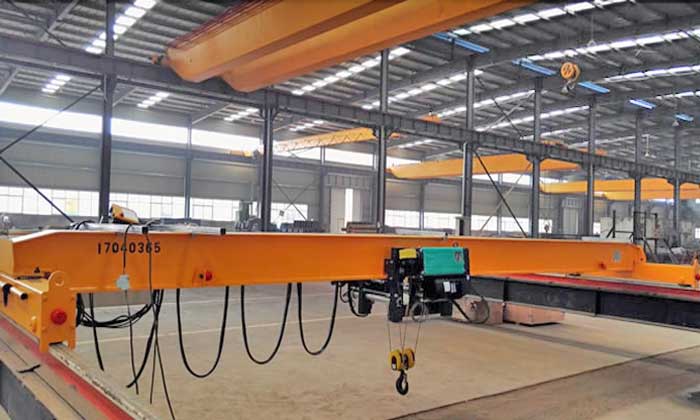
Single Girder Rolling Bridge Crane
Description: The single girder rolling bridge crane features a single bridge beam supported by end trucks. It is a cost-effective solution suitable for lighter loads and smaller workspaces. This design offers versatility and ease of installation, making it a popular choice for various applications.
Advantages:
- Cost-effective for lighter load capacities
- Suitable for smaller workspaces
- Versatile and relatively easy to install
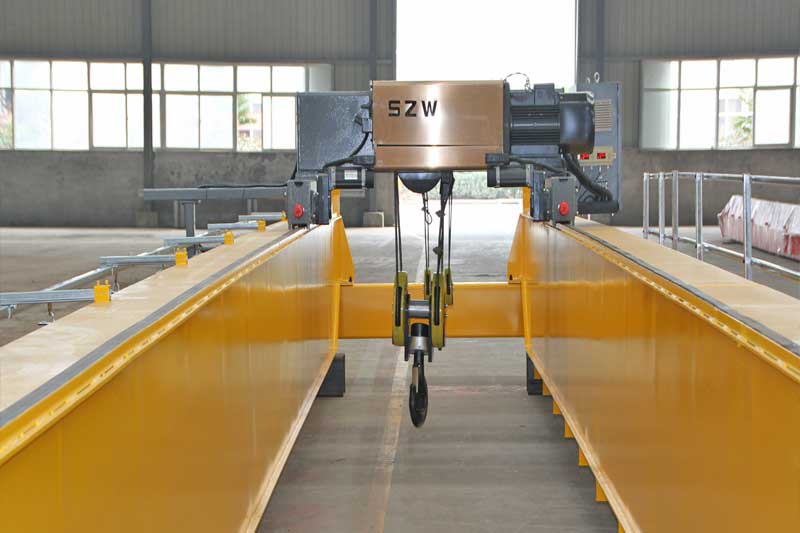
Double Girder Rolling Bridge Crane
Description: Unlike the single girder crane, this type incorporates two parallel bridge beams supported by end trucks. Double girder cranes are ideal for heavier loads and larger spans, providing enhanced stability and higher lifting capacities compared to their single girder counterparts.
Advantages:
- Higher load capacities and stability
- Suitable for larger workspaces and heavier loads
- Increased hook height and lift capabilities
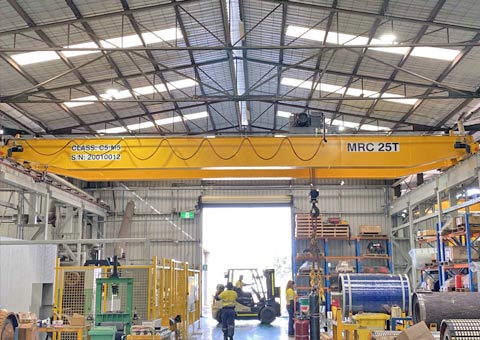
Top Running Rolling Bridge Crane
Description: Top running rolling bridge cranes are designed to run on rails or tracks installed on the top of the runway beams. This design allows for optimal use of vertical space, making them suitable for facilities where maximizing height clearance is crucial.
Advantages:
- Utilizes maximum vertical space
- Well-suited for facilities with height restrictions
- Provides efficient lifting and movement of loads
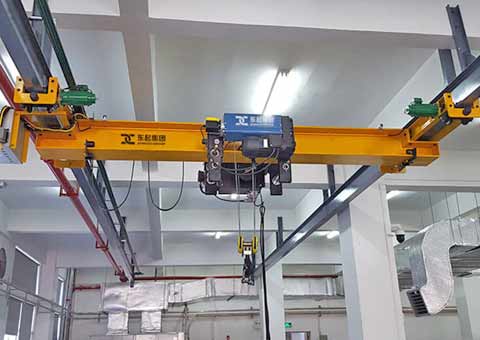
Underhung Rolling Bridge Cranes
Description: Underhung rolling bridge cranes differ from their top-running counterparts as they hang from the bottom flange of runway beams. They are often used in applications where headroom is limited or in buildings with crane runway systems already in place.
Advantages:
- Ideal for buildings with restricted headroom
- Offers flexible installation options
- Well-suited for retrofitting existing crane systems
Understanding the distinct features and advantages of each type of rolling bridge crane is essential for selecting the most suitable option based on load requirements, workspace limitations, and operational preferences. Choosing the right type ensures optimal performance and efficiency in material handling tasks within industrial environments.
Benefits and Applications of Each Type
Single Girder Rolling Bridge Crane:
Benefits:
- Cost-Effectiveness: Ideal for businesses with budget constraints due to its lower material and installation costs.
- Versatility: Suited for various applications, especially in smaller workspaces.
- Ease of Installation: Simple design facilitates easier installation compared to more complex systems.
Applications:
- Small to medium-sized manufacturing facilities
- Maintenance workshops
- Assembly lines with moderate load handling requirements
Double Girder Rolling Bridge Crane:
Benefits:
- High Load Capacities: Provides increased lifting capabilities suitable for heavier loads.
- Enhanced Stability: Offers superior stability and durability due to the double girder design.
- Increased Hook Height: Ideal for tasks requiring higher hook height and lift capabilities.
Applications:
- Heavy manufacturing industries (steel mills, foundries)
- Warehouses with heavy materials
- Construction sites handling substantial loads
Top Running Rolling Bridge Crane:
Benefits:
- Space Optimization: Efficiently utilizes vertical space, making it suitable for facilities with height restrictions.
- Flexibility: Offers smooth movement along the top runway beams, allowing for precise load handling.
Applications:
- Facilities with limited overhead clearance
- Workspaces needing efficient use of vertical space
- Industries requiring precise and controlled movement of loads
Underhung Rolling Bridge Cranes:
Benefits:
- Headroom Conservation: Ideal for buildings with limited headroom where traditional top-running cranes might not be suitable.
- Flexibility in Installation: Allows installation flexibility in buildings with existing structures or limited space.
Applications:
- Workshops or warehouses with restricted overhead space
- Retrofitting existing crane systems in facilities
Understanding the distinct benefits and applications of each type of rolling bridge crane is crucial for selecting the most suitable option based on specific operational requirements and constraints. Each type offers unique advantages, making them appropriate for different industrial applications and environments. Choosing the right type of rolling bridge crane optimizes efficiency and productivity in material handling operations.
Customized of Rolling Bridge Crane and Optional Features
Rolling bridge cranes can be tailored to meet specific operational needs through customization and the addition of optional features. These enhancements ensure optimal performance and increased efficiency in material handling tasks. Some customization options and optional features include:
- Load Capacity Adjustment: - Tailoring the crane's load capacity to meet specific weight requirements of the application.
- Span Length Modification: - Adjusting the span length to accommodate various workspace dimensions.
- Hoist Speed and Control Customization: - Customizing hoist speed and control systems for precise load handling and movement.
- Installation Adaptability: - Tailoring the crane design to suit specific installation requirements, especially in unique or constrained spaces.
Optional Features:
- Remote Control Systems: - Integration of remote control functionality for increased operator convenience and precision in load handling.
- Collision Avoidance Systems: - Implementation of sensors or systems to prevent collisions and ensure enhanced safety during operations.
- Variable Frequency Drives (VFDs): - Incorporation of VFDs for improved energy efficiency and smoother operation of the crane.
- Load Monitoring and Management Systems: - Installation of sensors or systems to monitor load weight and distribution for safe and efficient handling.
- Environmental Protection Add-Ons: - Addition of weatherproofing or corrosion-resistant coatings for enhanced durability in challenging environments.
- Enhanced Safety Features: - Integration of additional safety mechanisms such as emergency stop buttons, overload protection, and warning signals.
Functionality and Operations
Working Mechanism of Rolling Bridge Cranes
Rolling bridge cranes operate on a straightforward yet efficient mechanism that enables the lifting, movement, and precise positioning of heavy loads within industrial settings. The working mechanism involves:
- Bridge Movement: The bridge, equipped with a hoist mechanism, moves horizontally along elevated runways. It is supported by end trucks or wheels that travel on the crane runway beams.
- Hoisting and Lowering: The hoist mechanism, mounted on the bridge, utilizes ropes, chains, or cables wound around a drum to hoist and lower loads as needed.
- Control Systems: Operators manage the crane's movement, lifting, and positioning through control panels or consoles, ensuring accuracy and safety during operations.
Advantages of Mobility and Flexibility
Rolling bridge cranes offer numerous advantages owing to their mobility and flexibility:
- Versatility: These cranes can navigate various areas within a workspace, enabling efficient handling of materials across different locations.
- Optimal Space Utilization: The ability to move horizontally along elevated runways maximizes floor space utilization, crucial in environments where space is at a premium.
- Precise Load Handling: Operators can precisely position heavy loads, facilitating accurate placement in production processes or storage areas.
- Quick and Efficient Material Handling: The mobility of rolling bridge cranes enables swift movement of materials, contributing to enhanced productivity and workflow efficiency.
Use Cases in Various Industries (Manufacturing, Warehousing, Construction, etc.)
Rolling bridge cranes find extensive applications across diverse industries:
- Manufacturing: Used for material handling in assembly lines, transporting heavy components, and aiding in production processes.
- Warehousing and Distribution: Efficiently lifts and moves goods within warehouses, streamlining storage and retrieval operations.
- Construction: Facilitates lifting and placement of construction materials at building sites, enhancing efficiency and safety in construction projects.
- Automotive Industry: Plays a vital role in handling vehicle components during manufacturing processes.
- Aerospace and Shipbuilding: Used for lifting and positioning heavy components in aircraft and shipbuilding facilities.
- Mining and Heavy Industries: Aids in material handling in mining operations and heavy industries involving substantial loads.
Rolling bridge cranes are indispensable in various sectors, offering unparalleled functionality, adaptability, and efficiency in material handling tasks across industries, ultimately contributing to improved productivity and safety standards.
Key Features and Considerations for Buyers
Load Capacity and Span
- Load Capacity: Buyers must assess the maximum weight a rolling bridge crane can lift safely. Consider the heaviest loads regularly handled and ensure the crane's capacity aligns with those requirements.
- Span Length: The span length determines the coverage area. Assess workspace dimensions to ensure the crane can traverse the entire area where lifting operations are required.
Hoist Speed and Control Systems
- Hoist Speed: The speed at which the hoist can lift and lower loads impacts productivity. Balance speed requirements with precision to optimize operations.
- Control Systems: Consider user-friendly control interfaces and the capability for precise load handling. Advanced control systems offer better accuracy and ease of operation.
Safety Features and Compliance Standards
- Safety Mechanisms: Evaluate the presence of safety features like overload protection, emergency stop buttons, and collision avoidance systems to ensure safe operations.
- Compliance Standards: Ensure the crane complies with industry safety standards and regulations, enhancing workplace safety and reducing liabilities.
Customization Options and Add-Ons
- Tailored Solutions: Assess the availability of customization options to meet specific operational needs, such as adjusting load capacity, hoist configurations, or installation adaptability.
- Optional Features: Consider additional features like remote control systems, load monitoring, or environmental protection add-ons for increased efficiency and durability.
Maintenance Requirements and Service Support
- Maintenance Needs: Evaluate maintenance schedules and requirements to ensure the crane's longevity. Opt for cranes with accessible components for easier maintenance.
- Service Support: Consider the availability of service support and spare parts to ensure timely maintenance and repair, minimizing downtime.
Careful consideration of these key features and factors is crucial for buyers when selecting a rolling bridge crane. A comprehensive evaluation based on load requirements, safety standards, customization options, and maintenance needs will ensure the chosen crane aligns perfectly with the operational demands, enhancing productivity and safety in industrial settings.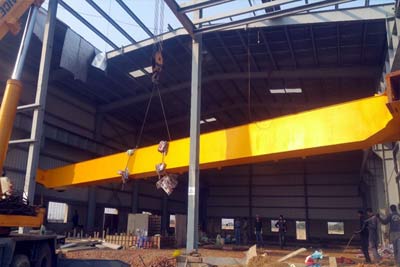
Installation and Best Practices
Planning for Installation
- Site Evaluation: Conduct a thorough assessment of the workspace to determine suitable locations for installing runways and supporting structures.
- Structural Considerations: Ensure the building or structure can support the crane's weight and load capacities without compromising safety.
- Coordination with Professionals: Collaborate with engineers and crane installation experts to design and plan the installation process efficiently.
Safety Measures During Installation and Use
- Adherence to Safety Protocols: Prioritize safety during installation by following safety guidelines, using appropriate personal protective equipment (PPE), and securing the work area.
- Regular Inspections: Conduct routine checks and inspections to identify potential hazards or malfunctions, ensuring safe and efficient crane operations.
Training for Operators
- Operator Training: Provide comprehensive training to crane operators on proper usage, control systems, safety procedures, and emergency protocols.
- Ongoing Education: Encourage continuous learning and skill development to keep operators updated with the latest safety regulations and operational best practices.
Maintenance Tips for Prolonged Lifespan
- Scheduled Maintenance: Implement a regular maintenance schedule that includes lubrication, inspection of components, and addressing minor issues promptly.
- Professional Support: Engage certified technicians or service providers for periodic maintenance and repairs to ensure optimal functionality and prolonged lifespan of the crane.
Adhering to best practices during installation, emphasizing safety measures, providing thorough training to operators, and implementing a structured maintenance regime are critical for ensuring the safe and efficient operation of rolling bridge cranes. These practices contribute significantly to prolonged crane lifespan and sustained productivity in industrial environments.
Cost Analysis and Return on Investment (ROI)
Initial Costs vs. Long-Term Benefits
- Initial Costs: Evaluate the upfront expenses including purchase price, installation, and any customization required for the rolling bridge crane.
- Long-Term Benefits: Consider the long-term advantages such as increased productivity, reduced labor costs, minimized material damage, and improved operational efficiency.
Factors Affecting Cost (Size, Features, Installation, etc.)
- Size and Capacity: Larger cranes with higher load capacities generally incur higher costs due to increased materials and structural requirements.
- Features and Customization: Additional features and customization options may add to the initial cost but can enhance operational efficiency, potentially providing substantial long-term benefits.
- Installation Complexity: Factors like site preparation, structural modifications, and installation complexity can influence overall costs.
Calculating ROI for Rolling Bridge Crane Investments
- ROI Calculation: Calculate ROI by comparing the total investment (initial cost, installation, maintenance) with the expected gains over the crane's lifespan.
- Factors to Consider: Consider factors such as increased productivity, reduced labor costs, minimized material wastage, and improved safety when calculating ROI.
- Lifespan and Maintenance Costs: Factor in the expected lifespan of the crane and ongoing maintenance costs to determine the net ROI over time.
Conducting a thorough cost analysis that considers both initial investment and long-term benefits is essential for assessing the true value and potential return on investment of rolling bridge crane purchases. It enables informed decision-making regarding the purchase and helps justify the investment based on expected gains and efficiency improvements in industrial operations.
Case Studies and Success Stories
Real-life Examples of Rolling Bridge Crane Implementations
- Manufacturing Facility Case Study: XYZ Manufacturing implemented a double girder rolling bridge crane to streamline their assembly line processes. The crane's flexibility and high load capacity significantly reduced material handling time, resulting in a 25% increase in production output within the first six months.
- Warehouse Optimization: ABC Logistics adopted top running rolling bridge cranes in their warehouse. The cranes efficiently utilized vertical space, allowing for more effective storage and retrieval, leading to a 30% increase in warehouse storage capacity.
Impact on Efficiency, Productivity, and Safety in Different Industries
- Manufacturing Industry: Rolling bridge cranes in manufacturing plants have notably improved efficiency by reducing manual handling, minimizing production downtime, and enhancing workplace safety by reducing accidents related to material handling.
- Warehousing and Distribution: Implementation of rolling bridge cranes in warehouses has resulted in streamlined operations, faster material handling, improved inventory management, and reduced labor costs, positively impacting overall productivity.
- Construction Sector: In the construction industry, rolling bridge cranes have expedited material movement on-site, facilitated precise positioning of heavy components, and enhanced worker safety by minimizing manual lifting and handling of construction materials.
Rolling bridge cranes have showcased their effectiveness across various industries, demonstrating significant improvements in efficiency, productivity, and safety. Real-life case studies and success stories highlight how these cranes have revolutionized material handling processes, leading to tangible benefits for businesses in diverse sectors.
Wrap it Up,
In summary, the comprehensive guide to rolling bridge cranes highlights essential aspects crucial for buyers and users:
- Understanding the working mechanism and types of rolling bridge cranes.
- Key considerations such as load capacity, safety features, customization options, and maintenance requirements.
- Installation best practices, emphasizing safety, planning, operator training, and maintenance.
- Cost analysis, ROI calculation, and real-life case studies illustrating the benefits of rolling bridge cranes in various industries.
Final Thoughts on the Importance of Rolling Bridge Cranes in Industrial Operations
Rolling bridge cranes play an integral role in enhancing efficiency, safety, and productivity within industrial settings. Their versatility, mobility, and ability to handle heavy loads efficiently make them indispensable assets across diverse industries. By streamlining material handling processes, optimizing workspace utilization, and improving safety standards, rolling bridge cranes significantly contribute to the success and growth of businesses, ultimately enabling them to stay competitive in today's dynamic market.
Investing in the right rolling bridge crane tailored to specific operational needs is not just an acquisition; it's an investment in the future of streamlined operations, increased productivity, and safer work environments. The importance of these cranes in industrial operations cannot be overstated, and their continued innovation and integration of advanced technologies will only further enhance their significance in the evolving industrial landscape.




